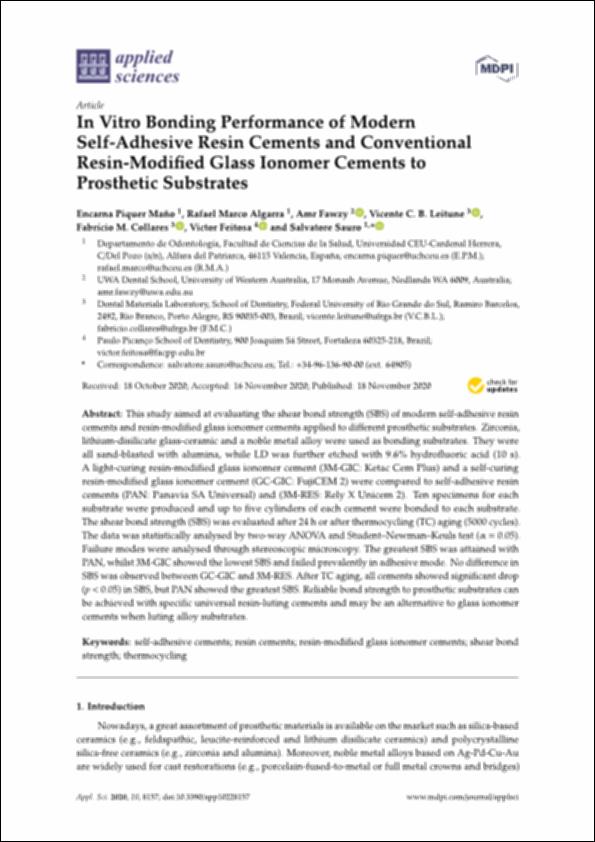Please use this identifier to cite or link to this item:
http://hdl.handle.net/10637/12556In vitro bonding performance of modern self-adhesive resin cements and conventional resin-modified glass ionomer cements to prosthetic substrates
| Title: | In vitro bonding performance of modern self-adhesive resin cements and conventional resin-modified glass ionomer cements to prosthetic substrates |
| Authors : | Piquer Mañó, Encarna Marco Algarra, Rafael Fawzy, Amr Branco Leitune, Vicente Castelo Collares, Fabrício M. Feitosa, Victor Pinheiro Sauro, Salvatore. |
| Keywords: | Materiales dentales.; Dental materials.; Adhesivos dentales.; Gums and resins in Dentistry.; Cementos dentales.; Dental cements.; Gomas y resinas - Aplicaciones en Odontología.; Dental adhesives. |
| Publisher: | MDPI |
| Citation: | Piquer Maño, E., Marco Algarra, R., Fawzy, A., Branco Leitune, V.C., Collares, F.M., Feitosa, V. et al. (2020). In vitro bonding performance of modern self-adhesive resin cements and conventional resin-modified glass ionomer cements to prosthetic substrates. Applied Sciences, vol. 10, i. 22 (18 nov.), art. 8157. DOI: https://doi.org/10.3390/app10228157 |
| Abstract: | This study aimed at evaluating the shear bond strength (SBS) of modern self-adhesive resin cements and resin-modified glass ionomer cements applied to di erent prosthetic substrates. Zirconia, lithium-disilicate glass-ceramic and a noble metal alloy were used as bonding substrates. They were all sand-blasted with alumina, while LD was further etched with 9.6% hydrofluoric acid (10 s). A light-curing resin-modified glass ionomer cement (3M-GIC: Ketac Cem Plus) and a self-curing resin-modified glass ionomer cement (GC-GIC: FujiCEM 2) were compared to self-adhesive resin cements (PAN: Panavia SA Universal) and (3M-RES: Rely X Unicem 2). Ten specimens for each substrate were produced and up to five cylinders of each cement were bonded to each substrate. The shear bond strength (SBS) was evaluated after 24 h or after thermocycling (TC) aging (5000 cycles). The data was statistically analysed by two-way ANOVA and Student–Newman–Keuls test ( = 0.05). Failure modes were analysed through stereoscopic microscopy. The greatest SBS was attained with PAN, whilst 3M-GIC showed the lowest SBS and failed prevalently in adhesive mode. No di erence in SBS was observed between GC-GIC and 3M-RES. After TC aging, all cements showed significant drop (p < 0.05) in SBS, but PAN showed the greatest SBS. Reliable bond strength to prosthetic substrates can be achieved with specific universal resin-luting cements and may be an alternative to glass ionomer cements when luting alloy substrates. |
| Description: | Este artículo se encuentra disponible en la siguiente URL: https://www.mdpi.com/2076-3417/10/22/8157 Este artículo pertenece al número especial "Developments and applications of dental materials". |
| URI: | http://hdl.handle.net/10637/12556 |
| Rights : | http://creativecommons.org/licenses/by/4.0/deed.es |
| ISSN: | 2076-3417 (Electrónico). |
| Issue Date: | 18-Nov-2020 |
| Center : | Universidad Cardenal Herrera-CEU |
| Appears in Collections: | Dpto. Odontología |
Items in DSpace are protected by copyright, with all rights reserved, unless otherwise indicated.


